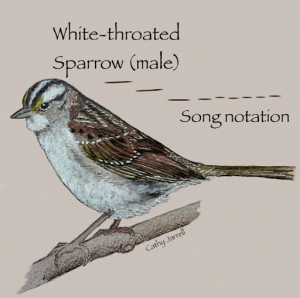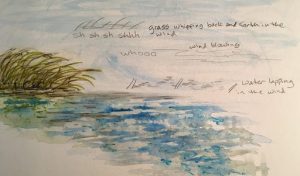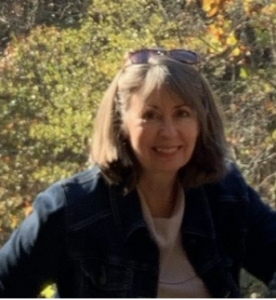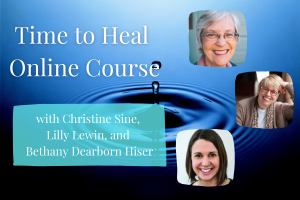guest post and photos by Cathy Jarrell,
A few years ago, I took up nature journaling. The beauty and diversity of God’s natural world touch me deeply, and I find that sketching the plants, animals, and landscape features that catch my eye helps me discover nuances in their forms that fill me with wonder.
But it’s not just the visual part of creation that catches my attention. Sounds that are beautiful, arresting, curious, or even dissonant meld into a transient composition, a fleeting moment in time, that adds dimension to what I observe, or stands alone as its own expression of natural beauty. Soundscapes that include birdsong, insect calls, wind rustling the leaves, and animal patter uniquely identify a particular time and place, never to be heard exactly the same way again. Summer provides a rich soundscape as birds fledge their nests, tree frogs trill to one another, and rainstorms pelt the trees. If you live somewhere with distinct seasons, each has its own soundscape: the sounds of falling, scattering leaves and migrating birds in autumn, the sounds of crunching snow or falling ice pellets in winter, and the waking-up sounds of calling frogs, singing birds, and grazing deer in spring.

by Cathy Jarrell
When I hear a bird, I can certainly attempt to sketch it in my journal. But how do I capture its song? Many people develop their own notation to help them capture the rhythm and rise and fall of birdsong notes. But how do I capture the sound of water and plants moving in the wind? Sound mapping is a visual way to capture those sounds. I particularly like sound mapping because it is so uniquely personal; it’s like my own code that only I need recognize.
A nature journal can include whatever moves you: sketches of plants and animals, scientific facts you’ve learned about

by Cathy Jarrell
them, poetry, or prose describing how you feel when you’re in nature. But I think there is a place for mapping many kinds of soundscapes in a prayer journal, too. Listening is an underrated part of prayer. Often, we think of all the things we want to say to God, but we fail to then become still and listen. If we’re praying outdoors, we have a wonderful opportunity to incorporate the nature sounds we hear into our prayer time. We can either let the sounds we hear pass through and simply enjoy them, or we can allow them to spur additional prayers that perhaps we had not considered before. Pleasing sounds may elicit feelings of appreciation and gratitude. Annoying sounds may provide an opportunity to be more charitable. Think of these typical summer sounds and the prayers they could elicit:
Lawnmower: perhaps an annoying sound, but let it spur a prayer for the safety of the person mowing and give thanks for those who labor outdoors, sometimes in harsh weather.
Birdsong: marvel at the beauty and diversity of God’s creation and consider the intricate relationships of birds, insects, plants, and humans. This can be an opportunity to pray for protection for declining bird populations and perhaps to pray for guidance about how to serve God by caring for creation.
A neighbor starting the car and driving away: give thanks for community and ask God to bless our neighbors and their families.
Moving water and rain: thank God for the amazing network of streams, rivers, and oceans that sustain all life and the cycle of water that rises to heaven and falls to earth again and again. Consider the symbolism of water in our faith: the purifying waters of baptism, the living water offered by Christ, the faithful person who is like a tree planted by streams of water.
Wind: give thanks for the Spirit of God. “The wind blows wherever it pleases. You hear its sound, but you cannot tell where it comes from or where it is going. So it is with everyone born of the Spirit.” John 3:8, NIV
Even complete silence is a kind of soundscape. What does silence feel like to you? Is there a sense of God’s presence? Is silence healing or calming, or does it make you feel lonely or anxious? How would you draw or symbolize silence and the feelings they elicit in your journal?
The world is full of chaos, and no small part of that chaos comes in the form of noise. Add to that the constant busyness that engulfs our minds and swallows up our thoughts, and over time we can find ourselves completely estranged from nature and from any sense of peace. Listening can stop the endless train of thought. Attending to the sounds we hear can give us a much-needed connection to the rest of creation, including our fellow creatures and our neighbors. If you’re really listening, your mind cannot spiral in all directions. The best kind of listening balances attentive listening with introspection. Listen first. Then wait for what comes to mind. Perhaps you will hear a bird call that you never noticed before. Perhaps you will hear your neighbor’s children joyfully playing. Perhaps you will hear nothing but refreshing, peaceful silence.
Perhaps you will hear the still, small voice of God.
Bio for Cathy Jarrell
 Cathy Jarrell is a retired medical writer, editor, and publisher. She enjoys nature walks with her husband, Sam, at their home in Saint Charles, Missouri, USA. Cathy enjoys many artistic pursuits, including painting and photography, mostly centering on the beauty of the natural world. Her primary writing interest concerns the intersection of human life and the natural world.
Cathy Jarrell is a retired medical writer, editor, and publisher. She enjoys nature walks with her husband, Sam, at their home in Saint Charles, Missouri, USA. Cathy enjoys many artistic pursuits, including painting and photography, mostly centering on the beauty of the natural world. Her primary writing interest concerns the intersection of human life and the natural world.
Embark on this healing journey with Christine Sine, Lilly Lewin, and Bethany Dearborn Hiser with the Time to Heal Online Course. Each session is lead by one of our instructors and allows you 180 days of access for only $39.99. The goal of this course is to provide time, space, and tools to work toward healing.


